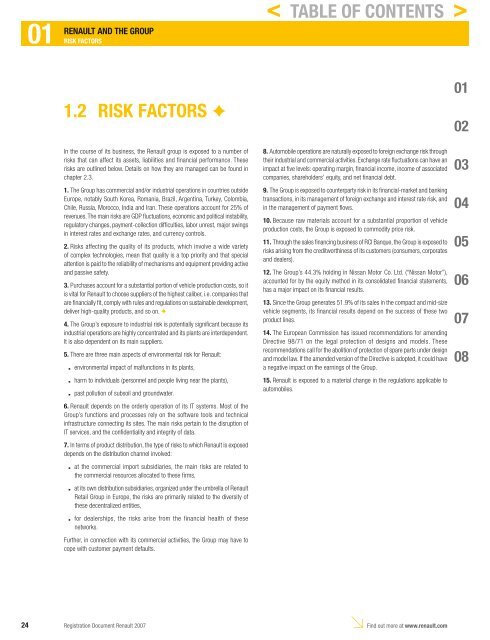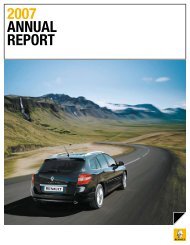2007 Interactive Registration Document - Renault
2007 Interactive Registration Document - Renault
2007 Interactive Registration Document - Renault
You also want an ePaper? Increase the reach of your titles
YUMPU automatically turns print PDFs into web optimized ePapers that Google loves.
01 RISK<br />
RENAULT AND THE GROUP<br />
FACTORS<br />
1.2 RISK FACTORS ✦<br />
In the course of its business, the <strong>Renault</strong> group is exposed to a number of<br />
risks that can affect its assets, liabilities and fi nancial performance. These<br />
risks are outlined below. Details on how they are managed can be found in<br />
c hapter 2.3.<br />
1. The Group has commercial and/or industrial operations in countries outside<br />
Europe, notably South Korea, Romania, Brazil, Argentina, Turkey, Colombia,<br />
Chile, Russia, Morocco, India and Iran. These operations account for 25% of<br />
revenues. The main risks are GDP fl uctuations, economic and political instability,<br />
regulatory changes, payment-collection diffi culties, labor unrest, major swings<br />
in interest rates and exchange rates, and currency controls.<br />
2. Risks affecting the quality of its products, which involve a wide variety<br />
of complex technologies, mean that quality is a top priority and that special<br />
attention is paid to the reliability of mechanisms and equipment providing active<br />
and passive safety.<br />
3. Purchases account for a substantial portion of vehicle production costs, so it<br />
is vital for <strong>Renault</strong> to choose suppliers of the highest caliber, i.e. companies that<br />
are fi nancially fi t, comply with rules and regulations on sustainable development,<br />
deliver high-quality products, and so on. ✦<br />
4. The Group’s exposure to industrial risk is potentially signifi cant because its<br />
industrial operations are highly concentrated and its plants are interdependent.<br />
It is also dependent on its main suppliers.<br />
5. There are three main aspects of environmental risk for <strong>Renault</strong>:<br />
.<br />
.<br />
.<br />
environmental impact of malfunctions in its plants,<br />
harm to individuals (personnel and people living near the plants),<br />
past pollution of subsoil and groundwater.<br />
6. <strong>Renault</strong> depends on the orderly operation of its IT systems. Most of the<br />
Group’s functions and processes rely on the software tools and technical<br />
infrastructure connecting its sites. The main risks pertain to the disruption of<br />
IT services, and the confi dentiality and integrity of data.<br />
7. In terms of product distribution, the type of risks to which <strong>Renault</strong> is exposed<br />
depends on the distribution channel involved:<br />
.<br />
.<br />
.<br />
at the commercial import subsidiaries, the main risks are related to<br />
the commercial resources allocated to these fi rms,<br />
at its own distribution subsidiaries, organized under the umbrella of <strong>Renault</strong><br />
Retail Group in Europe, the risks are primarily related to the diversity of<br />
these decentralized entities,<br />
for dealerships, the risks arise from the financial health of these<br />
networks.<br />
Further, in connection with its commercial activities, the Group may have to<br />
cope with customer payment defaults.<br />
< TABLE OF CONTENTS ><br />
8. Automobile operations are naturally exposed to foreign exchange risk through<br />
their industrial and commercial activities. Exchange rate fl uctuations can have an<br />
impact at fi ve levels: operating margin, fi nancial income, income of associated<br />
companies, shareholders’ equity, and net fi nancial debt.<br />
9. The Group is exposed to counterparty risk in its fi nancial-market and banking<br />
transactions, in its management of foreign exchange and interest rate risk, and<br />
in the management of payment fl ows.<br />
10. Because raw materials account for a substantial proportion of vehicle<br />
production costs, the Group is exposed to commodity price risk.<br />
11. Through the sales fi nancing business of RCI Banque, the Group is exposed to<br />
risks arising from the creditworthiness of its customers (consumers , corporates<br />
and dealers).<br />
12. The Group’s 44.3% holding in Nissan Motor Co. Ltd. (“Nissan Motor”),<br />
accounted for by the equity method in its consolidated fi nancial statements,<br />
has a major impact on its fi nancial results.<br />
13. Since the Group generates 51.9% of its sales in the compact and mid-size<br />
vehicle segments, its fi nancial results depend on the success of these two<br />
product lines.<br />
14. The European Commission has issued recommendations for amending<br />
Directive 98/71 on the legal protection of designs and models. These<br />
recommendations call for the abolition of protection of spare parts under design<br />
and model law. If the amended version of the Directive is adopted, it could have<br />
a negative impact on the earnings of the Group.<br />
15. <strong>Renault</strong> is exposed to a material change in the regulations applicable to<br />
automobiles.<br />
24 <strong>Registration</strong> <strong>Document</strong> <strong>Renault</strong> <strong>2007</strong><br />
Find out more at www.renault.com<br />
01<br />
02<br />
03<br />
04<br />
05<br />
06<br />
07<br />
08




